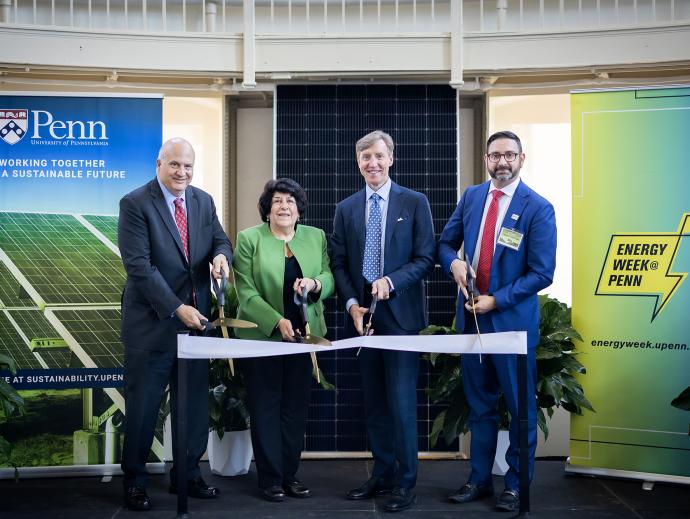Committed to 100% Carbon Neutrality
The University of Pennsylvania has signed a Power Purchase Agreement (PPA) for the creation of a solar power project moving the University significantly closer to meeting its commitment of a 100% carbon neutral campus by 2042. (Photo credit: AES)
Committed to 100% Carbon Neutrality
The University of Pennsylvania has signed a Power Purchase Agreement (PPA) for the creation of a solar power project moving the University significantly closer to meeting its commitment of a 100% carbon neutral campus by 2042. (Photo credit: AES)
Power Purchase Agreement
At a Glance
Purpose: Penn’s PPA moves the University significantly closer to meeting its commitment of a 100% carbon neutral campus by 2042.
Completed: December 2023
Location: Central Pennsylvania
Solar Facilities Size: 220 megawatts
Solar Energy Production: Approximately 420,000 MWh, roughly 70% of the total electricity demand of the academic campus and the University of Pennsylvania Health System.
Related Initiatives: Climate and Energy
“This agreement not only allows the University of Pennsylvania to continue to demonstrate strong leadership on climate action, but it also provides a competitive price on electricity,”
FAQs
A solar power purchase agreement (PPA) is a financial agreement between a solar project developer and customer. The developer agrees to design, build, and deliver the solar power from the system while the customer agrees to purchase the power generated by the system. In this case, the University of Pennsylvania (Penn) is purchasing solar electricity from AES, the developer.
Many of our Ivy+ peers have signed PPAs as well (mostly solar, but some wind), but Penn’s is the largest at 220 MW.
- Johns Hopkins - 175 MW
- Stanford - 67 MW
- MIT - 44 MW
- Georgetown - 32.5 MW
- Harvard - 12 MW
In terms of the Pennsylvania region, many of our peers have signed PPAs as well, but again, Penn’s is by far the largest.
- Penn State - 70 MW
- Partnership between Lehigh, Lafayette, Muhlenberg, and Dickinson - 45.9 MW
- University of Pittsburgh - 17 MW
Penn has assessed the available roof space on campus and determined at this time that there is not enough space on campus to develop a sizable solar capacity.
There is always going to be market risk of market prices falling below our locked in price. In response to these concerns, we analyzed various scenarios that used current forward market pricing to evaluate the market risk over 25 years. The results showed a low level of risk for market prices to drop below our contracted price over the life of the PPA, well within the accepted levels for the University.
We do not have plans for another PPA at present. We are currently focusing on reduction of energy consumption on campus, which will reduce what we need to buy from the grid. Additionally, Penn has a goal of carbon neutrality by 2042. We are currently assessing a variety of avenues to achieve that goal.
Penn is procuring power from a solar developer and will not be involved in operation or maintenance of the facility. Any job training is outside of our purview.
Penn is working with the solar developer and the Environmental Innovations Initiative to identify research projects that are mutually beneficial. More information will be shared as available.
The project will put Penn on a solid path to its goal of carbon neutrality. These benefits were seen as optimal for Penn’s desire to address carbon emissions in mitigating the effects of climate change. Other potential impacts were considered but not included in the analysis
The project is expected to have a 35-40 year life. The project will be decommissioned at the end of its life. The steel posts that support the racking structure that hold the panels are pounded into the ground with no concrete footers so they can be fully removed at the end of the project’s life. Steel and aluminum parts are expected to be recycled. Solar panels are more than 80% glass and aluminum, so recycling of the panels is expected as well. The solar panel recycling industry is in its early stages of development as the vast majority of panels manufactured are still in operation. There are facilities in the US and abroad, and we expect solar panel recycling to grow as more and more panels are decommissioned.
Penn's primary commitment was to create additionality of alternative energy production. Over the 25-year contract, the rates are competitive with projected conventional electricity prices.
The PPA provides ~70% of Penn’s electricity of the academic campus and University of Pennsylvania Health System in the Greater Philadelphia area annually from a renewable source - approximately 400,000 MWh. This project reduces over 130,000 metric tons of greenhouse gas emissions, equaling an estimated 26% reduction of the academic campus’ emissions from its 2009 baseline.
The PPA contact includes $50,000/year for education and/or training associated with technical, operational, and economic aspects of renewable energy and energy storage. Currently, Penn researchers are exploring the impact of solar facilities on soil health at the Great Cove I & 2 facilities. You can read more on the Environmental Innovation Initiative’s Website (The soils beneath the solar fields | UPenn EII).
By reducing Penn’s emissions, Penn is helping the City of Philadelphia meet their citywide goal of carbon neutrality by 2050, and support’s PA’s Climate Action Plan by increasing renewable energy generation.



